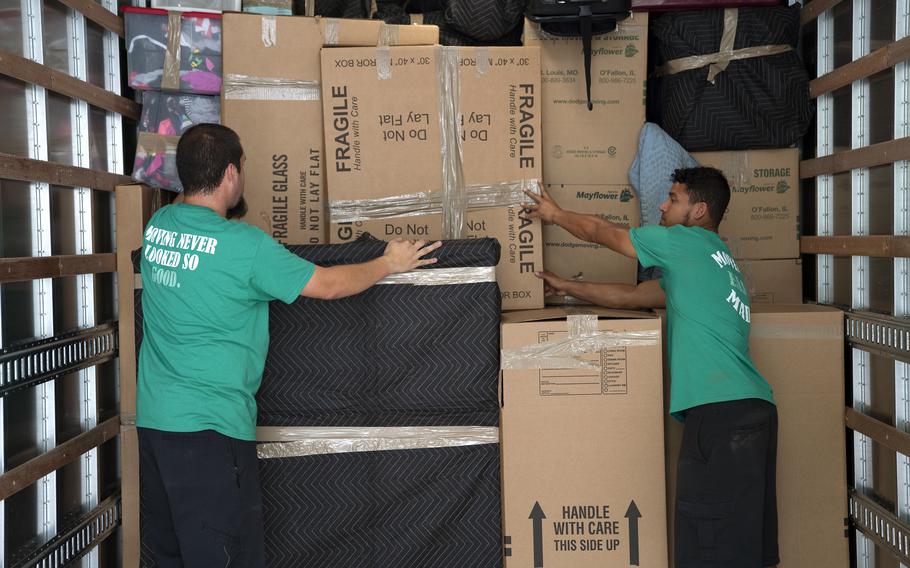
Movers at Scott Air Force Base, Ill., pack items belonging to a U.S. soldier moving to another state, June 12, 2019. (Stephenie Wade/U.S. Transportation Command)
Military families are incensed over sweeping cuts to reimbursement rates for service members who choose to manage their own moves when they change duty stations, rather than opt for defense contractors.
The reimbursement rates for personally procured moves have been slashed by as much as 40%, Megan Harless, an advocate for reforming the process for permanent changes of station, said by phone Wednesday.
That could leave many of the thousands of families choosing to self-move each year no choice but to use HomeSafe Alliance, the sole contractor chosen to oversee all household moves for the Defense Department, she said.
Much of the moving industry involved in military relocations has its own objections to contract rates offered by HomeSafe.
The U.S. Transportation Command awarded a $20 billion contract to Houston-based HomeSafe Alliance LLC in late 2021 to replace roughly 900 forwarding agents who have until now managed military moves.
HomeSafe is a joint venture between Tier One Relocation and KBR, formerly Kellogg Brown & Root.
HomeSafe moves are being made under the Global Household Goods Contract, or GHC, which has offered rates so low that much of the moving industry has not signed on.
The legacy Defense Personal Property Program, which still fulfills more than 99% of moves, is operating in parallel as the Global Household Goods Contract is phased in.
Petition for higher rates
Harless, whose Army husband is stationed at Fort Leavenworth, Kan., started a petition on change.org late last year aiming to move Congress to set higher rates for do-it-yourself moves.
The petition had garnered almost 33,000 signatures as of Thursday.
According to the petition, HomeSafe pays subcontractors 30-50% less than they are paid under the Defense Personal Property Program.
The petition claims that the HomeSafe reimbursement structure de-incentivizes service members from going the self-move route.
The Transportation Command said in an email Thursday that the petition is incorrect in saying that the rate being paid to service members for personally procured moves is based on what HomeSafe pays its subcontractors for similar moves.
That rate is set “independent of HomeSafe,” the command said.
‘Roll of the dice’
As it stands, some service members could end up spending thousands of their own dollars to cover the cost of a self-move, Harless said.
“Some families may not have that extra money to be able to afford that cost to do the move themselves,” she said.
Many service members avail themselves of self-moves.
In 2023, 82,977 households made full arrangements to move their goods, while another 37,399 made partial arrangements and moved some items by vehicle.
Rachel Griffith and her husband, an Army major stationed at Fort Knox, Ky., have used PPM for numerous moves over the past 12 years.
“Using government moving companies is consistently unpleasant, especially since the companies selected were likely the lowest bidders, and they often have questionable reputations and hire inexperienced packers,” she said in an email Thursday.
Griffith said they began self-moving after movers packed canned goods on top of a set of family heirloom crystal glasses and decanters.
She ticked off other reasons for choosing do-it-yourself moving.
“It’s not having strangers in our homes touching our personal items and hoping those strangers don’t pocket something they want,” she said. “Countless friends have had items stolen by movers, including jewelry and electronics, plus irreplaceable pieces, like the hospital baby blanket from their first child’s birth.”
While some movers are responsible and careful, “it’s a roll of the dice on what moving crew will show up at your house,” she said.